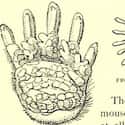(#1) Their Nose Tentacles - Or Rays - Are Extremely Sensitive
The star on the star-nosed mole's face consists of 22 tentacles the mole uses to sense the world around it. As it moves through the underground darkness, the mole utilizes the 100,000 sensory neurons embedded in its tentacles to detect food. Scientists call the tentacles "rays," and each set of 11 tentacles has a master ray to which the others react. When the master ray finds a potential source of food, the other rays begin feeling it out, too and quickly identify it so the mole can decide the proper course of action.
According to Natural History magazine, "Under a microscope, the... organs appear in a honeycombed pattern of tiny epidermal 'domes,' each sensitive to the slightest touch."
(#9) They Love Slimy Things
This strange-looking creature has an appetite for the things that typically seem gross to the human population, including earthworms, beetle larvae, and other invertebrates. Star-nosed moles living near water add crustaceans, mollusks, and amphibians - sometimes even dragonflies and damselflies as well - to their diets.
(#2) Their Snouts Have More Touch Sensitivity Than The Human Hand
Star-nosed moles are really touchy-feely, meaning they feel out the world around them to get a picture of how it looks. Their sensory organs act as eyes; the tentacles they use to search for prey each have thousands of what are known as Eimer's organs that show the moles what they are encountering and guide their movements as they burrow through the ground.
Although the celestial-looking snout of a star-nosed mole is only the size of a human fingertip, it has double the amount of sensory organs as an entire human hand: approximately 30,000, whereas a human hand has just 17,000.
(#10) They Are Partially Aquatic And Love To Burrow
The star-nosed mole inhabits territory ranging from the Eastern Seaboard to the Upper Midwest of the US and Canada. They typically make their homes near bodies of water and are semiaquatic, preferring to live near streams, rivers, lakes, and swamps.
Star-nosed moles like to live underground, but enjoy both cold and warm climates; these talpids construct tunnels where they live - anywhere from just below ground level to 60 centimeters under the surface.
(#7) Their Star Noses Are In Constant Motion When Exploring
According to Natural History magazine, "The star-nosed mole continuously scans its environment with its nose, much as [humans] constantly shift [their] eyes to perceive the world." Thousands of tiny sensors in constant movement send information to the mole's brain at lightning-quick speed, allowing the mole to make split-second decisions based primarily on touch.
(#6) They Devour Their Prey Outrageously Fast
It takes approximately 227 milliseconds for a star-nosed mole to identify and eat its prey. If that sounds fast, that's because it is. This mole is the fastest-eating animal in the world. Thanks to its teeth - which act as tweezers plucking small morsels out of the dirt for sustenance - the mole can get a meal and get it fast.
Also, the 22 tentacles on its face help locate food as the mole digs through the darkness. Scientists report that sometimes this star-shaped nose outpaces the mole's brain, causing the mole to skip over food until its nervous system can catch up and process what just happened.
New Random Displays Display All By Ranking
About This Tool
The star-nosed mole is a small mole found in eastern North America, eastern Canada, and the northeastern United States. They live in humid environments and feed on small invertebrates, aquatic insects, earthworms, and mollusks. Like other species of moles, star-nosed moles dig tunnels not far from the ground to find food, and the exits of these tunnels are usually under the water.
Studies have found that the star-nosed mole is the fastest-moving mammalian predator in the world. If you are interested in this small animal, welcome to check this random tool which introduced 11 facts about star-nosed moles that most people do not know.
Our data comes from Ranker, If you want to participate in the ranking of items displayed on this page, please click here.
















